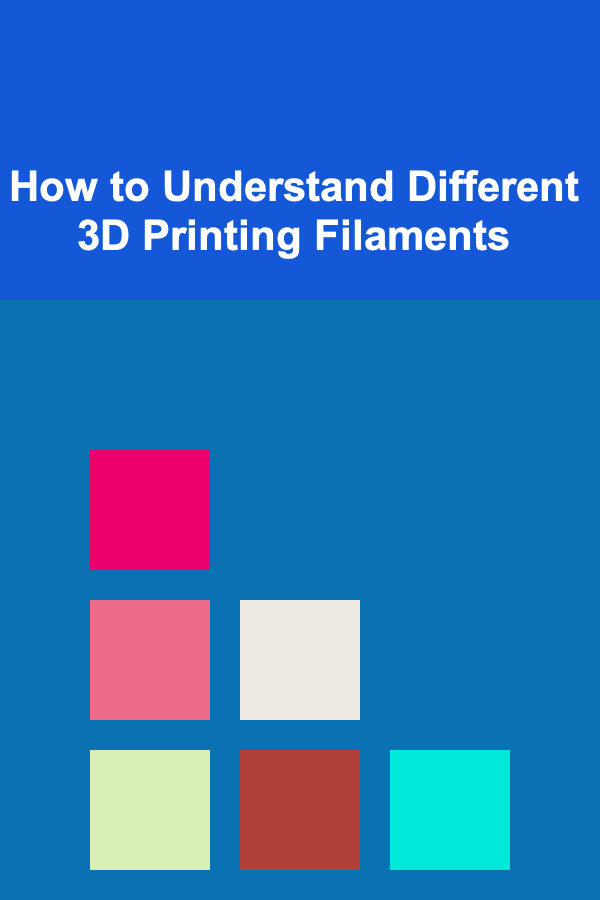
How to Understand Different 3D Printing Filaments
ebook include PDF & Audio bundle (Micro Guide)
$12.99$9.99
Limited Time Offer! Order within the next:

3D printing, also known as additive manufacturing, has rapidly evolved into one of the most innovative technologies of the 21st century. Its applications span across industries such as aerospace, automotive, healthcare, architecture, and more. One of the most critical aspects of 3D printing is the filament used to create 3D objects. Filament serves as the "ink" of 3D printing and plays a vital role in determining the final product's quality, strength, and usability. With a variety of filaments available on the market, understanding the differences between them can be overwhelming for both beginners and experienced users. This article aims to provide a comprehensive guide to understanding the different types of 3D printing filaments, their properties, uses, and considerations to help you make an informed decision about which filament to use for your projects.
What Is 3D Printing Filament?
In the world of 3D printing, filament refers to the material used in fused deposition modeling (FDM), the most common 3D printing process. The filament is heated and extruded through a nozzle to create layers that eventually form a three-dimensional object. Filaments come in various materials, colors, and sizes, each offering unique characteristics, such as flexibility, strength, durability, and ease of use.
There are many types of filaments available on the market, each suited for different applications. The choice of filament can significantly affect the final quality of the print, as well as the ease with which it can be printed.
Common Types of 3D Printing Filaments
1. PLA (Polylactic Acid)
Overview
PLA is the most popular and commonly used filament for 3D printing. It is a biodegradable thermoplastic made from renewable resources like corn starch or sugarcane, making it an eco-friendly option for environmentally conscious users.
Properties
- Ease of Use: PLA is known for being beginner-friendly, making it a go-to filament for most hobbyists and enthusiasts. It has low printing temperatures, usually between 180°C and 220°C, and doesn't require a heated bed, although it can benefit from one.
- Low Odor: PLA emits minimal odor during printing, which is a key advantage over some other filaments, especially in enclosed spaces.
- Strength and Durability: PLA is relatively rigid but can be brittle. It is not as durable as other filaments like ABS or PETG, and is not ideal for items subjected to mechanical stress.
Applications
- Prototyping: PLA is often used for creating visual prototypes and models.
- Toys and Household Items: Given its ease of printing and environmental friendliness, PLA is used for non-load-bearing objects such as toys, decorative items, and household goods.
Considerations
While PLA is great for most prints, it has some limitations, including a lower heat resistance and reduced durability. It can deform or lose shape at temperatures higher than 60°C, making it unsuitable for high-temperature applications.
2. ABS (Acrylonitrile Butadiene Styrene)
Overview
ABS is one of the most commonly used thermoplastics in 3D printing. It is a petroleum-based material known for its durability and toughness, which makes it ideal for functional parts.
Properties
- High Durability: ABS is known for its strength, heat resistance, and impact resistance. It can withstand temperatures up to 100°C before deforming, making it suitable for functional and mechanical parts.
- Warpage: One of the key challenges of printing with ABS is warping. ABS contracts as it cools, so a heated bed (typically set at 90°C to 110°C) is essential for successful prints.
- Odor: ABS emits fumes while printing, which can be unpleasant and potentially harmful. It's recommended to use ABS in a well-ventilated area or with an enclosure and filtration system to manage these fumes.
Applications
- Functional Prototypes: ABS is widely used for creating durable, high-strength prototypes, especially those that need to withstand mechanical stresses.
- Automotive Parts and Household Items: ABS is also popular for printing items like automotive parts, protective cases, and various consumer goods.
Considerations
ABS requires higher printing temperatures (typically 220°C to 250°C), and its tendency to warp can lead to difficulties in the printing process. It is also less eco-friendly than PLA, as it is derived from non-renewable resources.
3. PETG (Polyethylene Terephthalate Glycol)
Overview
PETG is a popular filament known for its excellent strength-to-weight ratio, durability, and ease of use. It is a modified version of PET (the material used for plastic bottles) and is often considered a more versatile alternative to PLA and ABS.
Properties
- Durability: PETG combines the rigidity of PLA with the toughness and flexibility of ABS, making it highly durable and impact-resistant.
- Low Warping: Unlike ABS, PETG is less prone to warping during the printing process, making it easier to print with and reducing the need for a heated bed (though a heated bed is still recommended).
- Transparency: PETG can be printed in transparent or translucent colors, making it a good choice for applications requiring clear parts.
Applications
- Functional Parts: Due to its strength and flexibility, PETG is commonly used for creating functional parts such as mechanical components, tools, and casings.
- Packaging and Medical Applications: PETG is also used in the production of packaging materials and medical devices due to its non-toxicity and resistance to moisture.
Considerations
PETG requires a printing temperature of around 230°C to 250°C, and while it is less prone to warping than ABS, it still requires some attention to detail when printing. It can be more prone to stringing (when small threads of filament are left behind during printing), but this can be managed with proper settings.
4. TPU (Thermoplastic Polyurethane)
Overview
TPU is a flexible, rubber-like filament that is prized for its elasticity and impact resistance. It is often used when a part needs to be flexible or bendable.
Properties
- Flexibility: TPU is one of the most flexible filaments available, capable of withstanding bending, stretching, and twisting without breaking.
- Durability: TPU is highly resistant to abrasion, making it ideal for parts that will be subjected to wear and tear.
- Printing Difficulty: TPU is more challenging to print with compared to rigid filaments like PLA and ABS. It requires a slower printing speed, and adjustments to the extruder and print settings may be necessary to prevent clogs.
Applications
- Flexible Parts: TPU is used in printing items like phone cases, gaskets, seals, and wearables, where flexibility and durability are essential.
- Footwear and Automotive Components: TPU is used for creating footwear soles, seals, and automotive parts that need to bend or stretch.
Considerations
TPU requires slower print speeds and careful handling to ensure proper extrusion. Additionally, TPU may require special printer modifications, such as a direct-drive extruder, to ensure a smooth printing process.
5. Nylon
Overview
Nylon is a strong, durable filament known for its excellent mechanical properties and ability to withstand high-stress environments. It is commonly used in industrial applications.
Properties
- Strength and Durability: Nylon is one of the strongest filaments available. It has excellent wear resistance and can withstand high levels of stress and impact.
- Flexibility: Nylon has a degree of flexibility and can be used to create parts that need to bend or absorb shock.
- Moisture Sensitivity: Nylon is hygroscopic, meaning it absorbs moisture from the air. This can affect its print quality and requires proper storage to prevent moisture absorption.
Applications
- Functional Parts: Nylon is commonly used to print mechanical parts such as gears, bearings, and hinges, as well as tools that need to endure heavy use.
- Textiles: Nylon is also used in the creation of textile products, such as flexible fabrics for wearables and soft goods.
Considerations
Nylon requires a higher printing temperature (around 240°C to 270°C) and a heated bed to prevent warping. Its tendency to absorb moisture means it should be stored in a dry environment to maintain print quality.
Choosing the Right Filament for Your Project
Choosing the right filament for your 3D printing project depends on several factors, including the type of object you are printing, its required strength, flexibility, and durability, as well as the environment in which it will be used.
- For Prototypes: PLA is an excellent choice for creating low-cost prototypes or visual models.
- For Durable Parts: If you need a durable, impact-resistant part, consider using ABS, PETG, or Nylon.
- For Flexible Items: TPU is the go-to filament for items that require flexibility, such as gaskets, phone cases, and wearables.
- For Food-Grade Applications: Filaments such as PETG and certain grades of PLA are suitable for creating food-safe objects, but always check the manufacturer's specifications to ensure safety.
Conclusion
Understanding the different types of 3D printing filaments is crucial to achieving successful prints that meet your project's requirements. Each filament has its own strengths, weaknesses, and unique properties, so selecting the right one involves considering factors such as material properties, ease of use, and intended application. Whether you are a beginner or an experienced 3D printer, having a thorough understanding of filament options will allow you to make informed decisions and optimize your printing process.

Building Scalable Passive Income with Deep Learning Projects
Read More
How to Create a Financial Plan for a Single Parent Household
Read More
How to Organize Your Entryway to Save Space and Reduce Clutter
Read More
How To Build a Content Marketing Funnel
Read More
How to Create Printable Pantry Labels That Actually Stick
Read More
10 Tips for Minimizing Investment Expense Ratios
Read MoreOther Products

Building Scalable Passive Income with Deep Learning Projects
Read More
How to Create a Financial Plan for a Single Parent Household
Read More
How to Organize Your Entryway to Save Space and Reduce Clutter
Read More
How To Build a Content Marketing Funnel
Read More
How to Create Printable Pantry Labels That Actually Stick
Read More